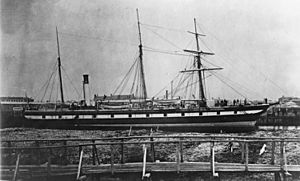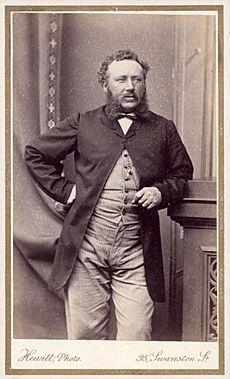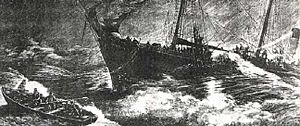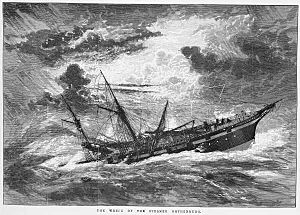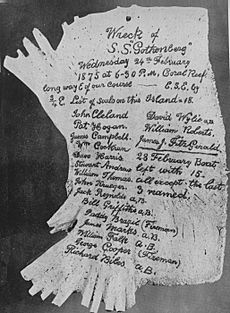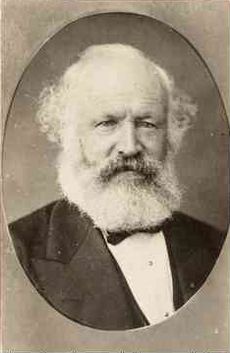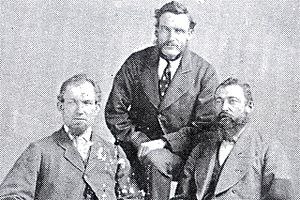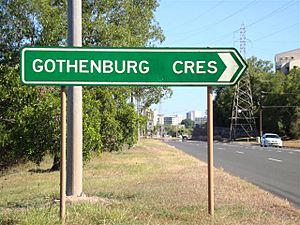SS Gothenburg facts for kids
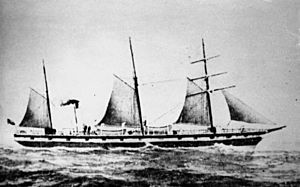
Gothenburg
|
|
Quick facts for kids History |
|
|---|---|
| Name | Gothenburg |
| Namesake | Gothenburg |
| Owner |
|
| Operator | 1854: J Hervey |
| Port of registry |
|
| Route |
|
| Builder | Charles Lungley & Co, Millwall |
| Launched | 1 April 1854 |
| Refit | rebuilt at Adelaide, 1873 |
| Identification | |
| Fate | wrecked, 24 February 1875 |
| General characteristics | |
| Tonnage |
|
| Length |
|
| Beam |
|
| Depth |
|
| Installed power | 120 hp |
| Propulsion | 2-cylinder steam engine |
| Sail plan | 3-masted barquentine |
| Crew | 34 |
The SS Gothenburg was a ship built in England in 1854. It was made of iron and used both sails and a steam engine to travel. For its first eight years, it sailed between England and Sweden. In 1862, the ship moved to Australia. There, it traveled across the Tasman Sea to and from New Zealand. In 1873, the Gothenburg was rebuilt to be even better. After that, it sailed along the coast of Australia, carrying goods and people.
In February 1875, the Gothenburg was caught in a terrible storm. It crashed into the Great Barrier Reef off the coast of Queensland. Only 22 people survived the shipwreck. Sadly, between 98 and 112 people died. Many important government officials and well-known people were among those who lost their lives.
Contents
Building the SS Gothenburg
Charles Lungley & Co built the Gothenburg in a place called Millwall on the River Thames in England. The ship was launched on April 1, 1854. However, its launch day had a problem. The Gothenburg crashed into another steamship called the Clyde. The Clyde sank, and the Gothenburg was damaged at its back (stern) and to its propeller.
When it was first built, the ship was about 187 feet (57 meters) long. It was about 28 feet (8.5 meters) wide and 13 feet (4 meters) deep. It weighed 572 GRT.
The Gothenburg had a two-cylinder steam engine. It was also a three-masted barquentine, meaning it had sails on three masts. Its single funnel (smokestack) was located towards the back of the ship. The ship carried four lifeboats, two on each side.
The first owner of the Gothenburg was the North of Europe Steam Navigation Company. They registered the ship in London.
Sailing the Seas
The North of Europe Steam Navigation Company used the Gothenburg to travel between London and Sweden. In 1862, a new owner named John H Blackwood bought the ship. He sailed it to Australia and registered it in Melbourne.
In the 1860s, the Gothenburg was one of the most modern ships in Australian waters. People liked it because it was considered very reliable. After several years of sailing between Australia and New Zealand, its owners moved it to serve the Australian coast.
Ship's Rebuild and New Routes
In 1873, the Gothenburg was rebuilt in Adelaide. This made the ship able to travel longer distances. It also allowed it to carry more cargo and more passengers.
After the rebuild, the ship was longer, about 196 feet (60 meters). Its width stayed about the same, but its depth increased to 20.5 feet (6.2 meters). Its weight also increased to 737 GRT. By 1874, the ship was owned by McMeckan and Blackwood.
In November 1874, the South Australian government hired several shipowners, including the Gothenburg's owners. They needed ships to make ten round trips over two years between Adelaide and Port Darwin. Port Darwin was growing fast because of a gold rush nearby. Banks, government papers, and mail all traveled by ship around the coast to Adelaide. The government would pay £1000 for each successful trip.
When the Gothenburg left Port Darwin on February 16, 1875, Captain Robert George Augustus Pearce was told to go as fast as possible. Captain Pearce was well-known for being a good and kind captain.
About 98 passengers and 37 crew members were on board. They included government officials, judges, miners, and even some prisoners. The French Vice Consul Edouard Durand and Dr. James Millner were also passengers. The ship also carried about 93 kilograms (205 pounds) of gold. This gold was worth a lot of money, about £40,000 at the time.
The first three days of the journey were fine. The Gothenburg traveled about 1500 kilometers (930 miles) to Somerset. The weather then started to get worse. The ship stopped to take on ballast (heavy material to keep it stable). While anchored, the storm became so bad that both anchor chains broke. The ship had to leave early because of strong currents.
Two days later, on February 23, the Gothenburg passed Cooktown. The wind and rain got much stronger, and thick clouds blocked the sun. Despite this, the ship continued south into the bad weather. It was sailing in a deep water path between the Queensland coast and the Great Barrier Reef. This path offered some protection, but captains still had to be careful of uncharted reefs. Everyone expected to reach Newcastle for a stopover.
The Shipwreck
On the evening of February 24, 1875, the ship was still heading south in almost cyclonic (hurricane-like) conditions. The steam engines were running at full speed. Heavy rains hit the entire Queensland coast. Captain Pearce could not see land or the sun. Around 7:00 PM, he changed course. Soon after, at full speed (11 to 12 knots), the ship hit a part of the Great Barrier Reef. This happened at low tide, about 31 miles (50 km) northwest of Holbourne Island. The Gothenburg hit the reef so hard that it was stuck high up.
At first, people were not scared. Many passengers went back to their cabins, thinking the ship would float free at high tide. Captain Pearce tried to make the ship lighter by moving water casks and passengers to the back. This was an effort to refloat it as the tide rose, but it did not work. Finally, a dangerous attempt was made to refloat the ship by reversing the engine very hard. The ship came partly off the reef, but it was badly damaged and then turned sideways to the waves. This made its situation much worse.
Even with the tide rising and some cargo being thrown overboard, everyone still hoped the Gothenburg would float free. But strong winds changed direction, and the seas grew rougher. Water rising through the damaged back of the ship put out the boiler fires. Around midnight, the chief engineer reported that the engine room was flooded. The engine could not be used anymore. Heavy seas were now rushing into the cabins. The Gothenburg was doomed, and Captain Pearce had to admit the situation was desperate.
The storm made it almost impossible to launch the lifeboats. Around 3:00 AM, Captain Pearce ordered the two left-side lifeboats to be lowered. Each had four crew members. One boat broke its rope and drifted away. The crew tried to get back to the ship, but the heavy storm made it impossible. The other lifeboat was accidentally let go. Both boats, in the rough seas, could not be brought back.
Around 3:30 AM on Thursday, February 25, the Gothenburg continued to tilt over. The deck became so steep that people had to climb over the rails to get to the side of the ship. Around 4:00 AM, the two remaining right-side lifeboats were lowered. Passengers rushed to get into them. One lifeboat, full of women and children, flipped over when others tried to get in. Some men managed to turn it right-side up in the water. But it was damaged and had no oars, food, or water. It quickly drifted away and was never found. The second right-side lifeboat also flipped over when a wave crashed into it. All the people in it were washed into the sea. One passenger remembered seeing human heads floating in the water like corks. Five or six men and one woman climbed onto the overturned hull of the boat. The boat was still connected to the ship by a rope. But the heavy sea and wind swept the woman off, and she drowned. A passenger named John Cleland swam to the overturned lifeboat and tied it more securely to the Gothenburg. In less than fifteen minutes, nearly 100 people had drowned. Many were washed away or trapped in their flooded cabins. By this time, several sharks were circling the wreck.
Those still on board the Gothenburg tried to hold onto the ropes and masts. But throughout the early morning of February 25, more people drowned. They were swept overboard by large waves hitting the ship sideways. Many passengers who were gold miners did not want to let go of their gold and money belts. This was probably their life savings. These people held onto their gold, and once they were in the water, they reportedly drowned very quickly.
Who Survived?
By the morning of February 25, only the masts of the ship could be seen above the water. Fourteen people were clinging to the rigging (ropes and masts). They stayed there for the next 24 hours in the stormy weather. At low tide, the Gothenburg sank back first, and the wreck broke apart. However, the remaining right-side lifeboat, which had flipped over, was still held by its rope and the rope tied by John Cleland.
At dawn on February 26, the weather got better. The survivors managed to turn the boat right-side up and empty the water from it. They made a simple sail and rowed towards the mainland. About seven hours later, they realized they could not reach the mainland. So, they changed course for an island they could see in the distance. When they arrived, they met four crew members from one of the left-side lifeboats. Their lifeboat had been badly damaged on the rocks on the other side of the island the day before.
The other left-side lifeboat, with four crew members, was picked up by the steamer Leichhardt at an island near Whitsunday Passage. The steamer immediately turned back towards the wreck. It reached the wreck around 3:30 PM on Friday, February 26. The Gothenburg was completely destroyed. The funnel was gone, and the ship had sunk deep into the water. The Leichhardt's Chief Officer and four crew went to the wreck, but only the masts could be seen. They thought the other victims had been taken by sharks. The Leichhardt searched for survivors until dark. Then, it sailed to Bowen to report the disaster.
At Holbourne Island, the other 18 survivors ate raw bird's eggs and drank rainwater from the rocks. Because they were not sure if they would be rescued, they carved ship details and their names onto a large turtle shell. They hoped someone would find it later. On Sunday, February 28, 15 of them left in the right-side lifeboat. They went to an island about 20 miles (32 km) south, which seemed closer to the main shipping route. A rescue ship looking for survivors picked up this group and took them safely to Bowen. Another rescue ship, the Bunyip from Townsville, later returned to Holbourne Island and rescued the three remaining survivors.
After the Disaster
Reports vary, but between 98 and 112 people drowned. Most records say 102 people died. Only 22 people survived (12 crew and 10 passengers). All 25 women and children on board died, as did all the ship's officers.
Edward W. Price, a government official, lost his wife and six children. He was very sad and given time off work. The former Premier of South Australia, Thomas Reynolds, and his wife, Anne, both drowned. The French Vice Consul, Eduard Durand, also died.
Many other important people died, including Dr. James Millner and his family, Judge William A. Wearing, and Joseph Whitby, a government lawyer. Many of the people who died lived in Darwin. News of the tragedy greatly affected the small community there. Most of the Gothenburg's crew were from Melbourne. The shipwreck left 11 widows and 34 children in Victoria needing help.
At Bowen, twelve survivors left on the ship Victoria for Sydney. The Gothenburg's owners, McMerkan, Blackwood and Co, gave them free passage. The four survivors picked up by the steamer Leichhardt stayed with that ship and later went to Brisbane.
Two weeks later, a diver went down to the wreck to get the gold and other valuables. He found the bodies of two women at the bottom of a staircase, holding onto each other. The diver tried to reach them to get something for their families, but his air line made it impossible. The gold in the Captain's cabin was recovered after much effort.
Three heroes were recognized for their bravery that night. They were passengers James Fitzgerald and John Cleland, and crewman Robert Brazil. On July 26, 1875, the Governor of South Australia, Sir Anthony Musgrave, gave them gold medals and gold watches. A special fund for the Gothenburg victims also gave them gold chains.
What Caused the Wreck?
A report by the Marine Board of Queensland looked into why the Gothenburg was lost. They said that the ship's loss was mostly due to strong currents pushing it out to sea. These currents were caused by heavy floods from rivers like the Burdekin flowing into the ocean. However, the report also said that the ship was not navigated carefully enough. They believed the captain should have tried to see the Cape Bowling Green Lighthouse or Cape Upstart. If not, they said the crew should have used a lead (a weighted rope to measure water depth). This tool could have helped them stay away from the Great Barrier Reef.
Lifeboats and Safety Rules
At the time, people in the newspapers wondered why the lifeboats were not launched earlier. Survivor James Fitzgerald said that if the lifeboats had been full, no one would have survived the severe weather. He also pointed out that passenger ships were not required to carry enough lifeboats for everyone on board. It was not until the RMS Titanic sank in 1912, about 37 years later, that it became a rule for all British ships to carry enough lifeboats for every person.
What Remains Today?
Today, only parts of the Gothenburg's iron hull and its coal-fired boilers remain. The wreck lies in 9 to 16 meters (30 to 52 feet) of water. It is on the western side of Old Reef, about 130 kilometers (81 miles) southeast of Townsville. The Gothenburg shipwreck is a Heritage site. It is protected by law, and divers need a permit to enter the 200-meter (656-foot) protected zone around the wreck. The reef around the wreck is good for diving and has many coral gardens. Divers must not disturb the marine life or the wreck itself. Pelagic fish (open-water fish) and reef sharks are often seen there.
Remembering the Lost
The northern Darwin suburb of Millner was named after Dr. James Millner. He and his family died on the Gothenburg. Many streets in the Darwin suburbs of Coconut Grove and Millner are named after people who lost their lives in the shipwreck. Gothenburg Crescent, in the Darwin suburb of Stuart Park, was named after the ship itself.
The large turtle shell, which the 18 survivors carved on Holbourne Island, is now on display. You can see it at the South Australian Museum in Adelaide.
Survivors
In 1875, a list of all passengers and crew was published. This list, with some corrections, is used for the table below.
List of Survivors
| Name | Status | Comment |
|---|---|---|
| Andrew, Stewart | Passenger | Gold miner |
| Bilts, Richard | Crew | Able Seaman |
| Brazil, Robert ("Paddy") | Crew | Fireman; awarded a Medal for bravery |
| Burns, William | Crew | Trimmer; rescued by the steamer Leichhardt |
| Campbell, James, J. | Passenger | Died shortly after rescue from being too cold |
| Cleland, John | Passenger | Gold miner; awarded a Medal for bravery |
| Cockrum, Thomas Gabriel | Passenger | Gold miner |
| Cooper, George | Crew | Fireman |
| Falk, John William | Crew | Able Seaman |
| Fitzgerald, James J. | Passenger | Awarded a medal for bravery |
| Griffiths, William ("Bill") | Crew | Able Seaman |
| Harris, David | Passenger | From Virginia Gold Mining Company |
| Halminson, Salin or Salve | Crew | Able Seaman; rescued by steamer Leichhardt |
| Hogan, Patrick J. | Passenger | Gold miner |
| Hudson, Joseph | Crew | Fireman; rescued by the steamer Leichhardt |
| Kruger, Jack | Passenger | Gold miner |
| Marks, James | Crew | Able Seaman |
| Nelson, Harry | Crew | Forecabin Steward; rescued by the steamer Leichhardt |
| Reynolds, Jack | Crew | Able Seaman |
| Roberts, William | Passenger | Gold miner |
| Thomas, William S. | Passenger | Purser of Winns Gold Mining Company, NT; only Saloon passenger to survive |
| Wylie, David | Crew | Able Seaman; Helmsman (steered the ship) when it hit the reef |
Images for kids


